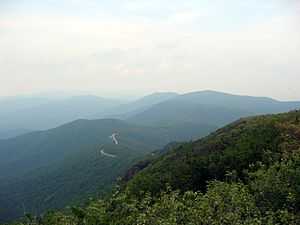Eastern Wilderness Act

The Eastern Wilderness Areas Act (P.L. 93-622) was signed into law by President Gerald Ford on January 3, 1975. Built upon the 1964 Wilderness Act, which was written by Howard Zahniser of The Wilderness Society and signed into law by President Lyndon B. Johnson, the Act designated 16 new wilderness areas in the eastern United States, including 207,000 acres (840 km2) of wilderness on national lands in 13 states.[2] Although originally untitled, the bill signed by Ford has come to be known as the Eastern Wilderness Areas Act.[3]
While the previous Act created the legal definition of wilderness in the United States, the Eastern Wilderness Areas Act only applied to land east of the 100th meridian.[4]
Background
In 1964, both the Forest Service and Congress agreed that eastern areas would have qualified as wilderness. However, six years later, the Forest Service opposed congressional designation of new wilderness areas in West Virginia with land use histories of logging. In 1971, they adopted a "purity" interpretation for wilderness designation, meaning that no lands with a history of human disturbance, East or West, could qualify as wilderness.[5]
The Forest Service drafted their own bill as an alternative, "to establish a system of wild areas within the land of the national forest system", which would have allowed cutting trees to "improve" wildlife habitat and recreation.[6] The organization described the bill as necessary because Eastern areas "do not meet the strict criteria of the Wilderness Act". Members of Congress who championed the Wilderness Act resolved to overturn the misconception that wilderness areas only included those that were "pristine" in nature. Senator Henry Jackson warned of this "serious and fundamental misinterpretation of the Wilderness Act" and pledged himself to correct the falsity of the so-called purity theory. Senator Frank Church, who had been leader of the Senate debate on the Wilderness Act, observed that "the effect of such an interpretation would be to automatically disqualify almost everything, for few if any lands on this continent—or any other—have escaped man’s imprint to some degree".
To counteract the Forest Service bill, advocates for wilderness—including The Wilderness Society, the Sierra Club, and Friends of the Earth, and their congressional allies—responded with the proposed Eastern Wilderness Areas Act. Promoted largely by Ernie Dickerman, a Wilderness Society staff member, and George Aiken, a senator from Vermont, the Senate endorsed the wilderness bill in May 1974.[7]
The final legislation adopted some elements of the Forest Service-inspired bill, but did not alter the definition and intent of the Wilderness Act of 1964. The previous debate regarding the meaning of "wilderness" versus "pristine" land led to the understanding that cultural use of lands should not keep the area from being restored to a "secondary wilderness" with functioning natural processes similar to when the land was in a primary state. Therefore, the Eastern Wilderness Areas Act not only explicitly protects lands which have suffered previous abuse, but that also have the ability to recover, and therefore be designated for wilderness protection.[8]
Notes
- ↑ "Shenandoah National Park Information Page". Shenandoah National Park. Retrieved on June 16, 2010.
- ↑ Rennicke, p. 55
- ↑ Johnson, p. 252
- ↑ "The Wilderness Act of 1964". Western North Carolina's Mountain Treasures. Retrieved on June 16, 2010.
- ↑ Scott, Douglas W. (2005). "Our Nationwide National Wilderness Preservation System". People, Places, and Parks: Proceedings of the 2005 George Wright Society Conference on Parks, Protected Areas, and Cultural Sites. Hancock, Michigan: The George Wright Society.
- ↑ Scott, p. 68
- ↑ Northup, Jim. (April 2001.) "George D. Aiken: Father of Eastern Wilderness". Forest Watch. Retrieved on June 16, 2010.
- ↑ Scott, p. 69
References
- Johnson, Christopher. This Grand & Magnificent Place: The Wilderness Heritage of the White Mountains. Durham, N.H.: University of New Hampshire Press, 2006.
- Rennicke, Jeff. (February 1992.) "Micro-Wild". Backpacker. Vol. 20, No. 112.
- Scott, Doug. The Enduring Wilderness. Golden, Colo.: Fulcrum Pub., 2004.